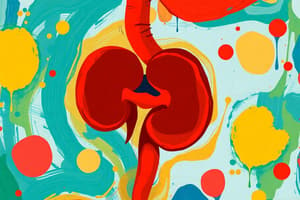Podcast
Questions and Answers
What is the laboratory finding that defines azotemia?
What is the laboratory finding that defines azotemia?
- Increased nitrogenous waste products (correct)
- Increased blood glucose
- Decreased platelet count
- Decreased white blood cells
What clinical manifestations define uremia?
What clinical manifestations define uremia?
- Increased blood pressure
- Symptoms of azotemia (correct)
- Decreased GFR
- Visible rashes on the skin
What does a significantly reduced GFR result in?
What does a significantly reduced GFR result in?
- Improved renal perfusion
- Increased nitrogenous waste products retention (correct)
- Decreased serum creatinine
- Reduced urea levels in the blood
What are the possible causes of significantly reduced GFR?
What are the possible causes of significantly reduced GFR?
In azotemia, what is attributed to the inability of the renal system to filter?
In azotemia, what is attributed to the inability of the renal system to filter?
Flashcards are hidden until you start studying
Study Notes
Azotemia and Uremia
- Azotemia is a laboratory finding characterized by increased levels of nitrogenous waste products, such as creatinine and urea, due to the kidneys' inability to filter waste (decreased GFR).
- Uremia refers to the clinical manifestations of azotemia, which can develop at varying levels of plasma creatinine depending on individual factors, including size, age, sex, underlying disease, concurrent illness, and true GFR.
Causes of Reduced GFR
- A significantly reduced GFR can result from:
- Reduced renal perfusion
- Intrinsic renal disease
- Postrenal processes (ureteral obstruction)
Consequences of Reduced GFR
- A reduced GFR leads to a rise in serum creatinine.
- It results in the retention of nitrogenous waste products, such as urea, in the body.
Studying That Suits You
Use AI to generate personalized quizzes and flashcards to suit your learning preferences.




